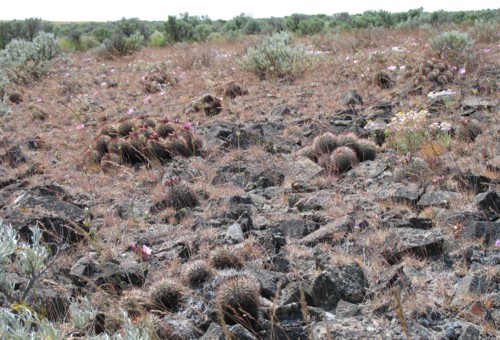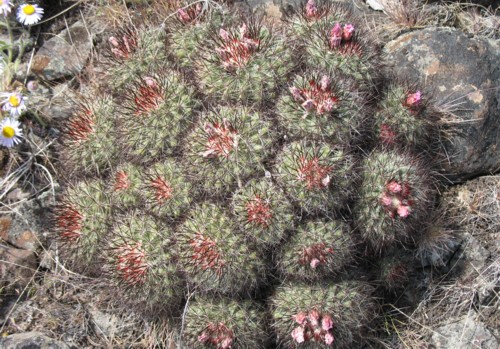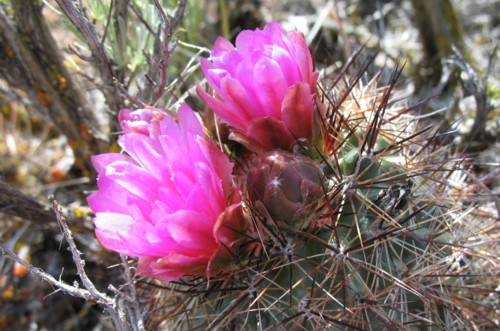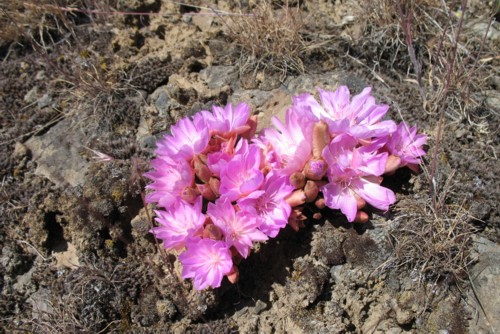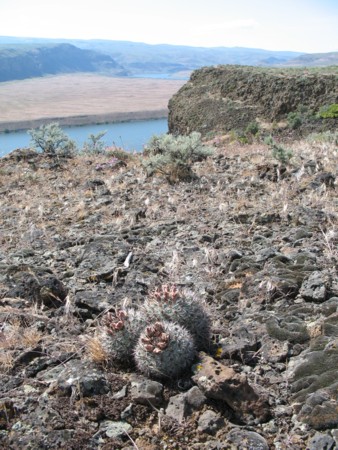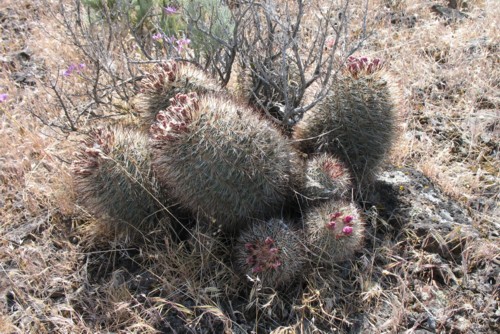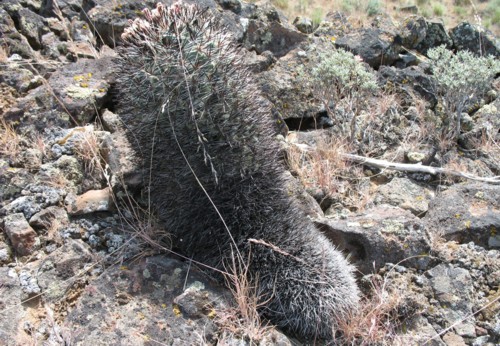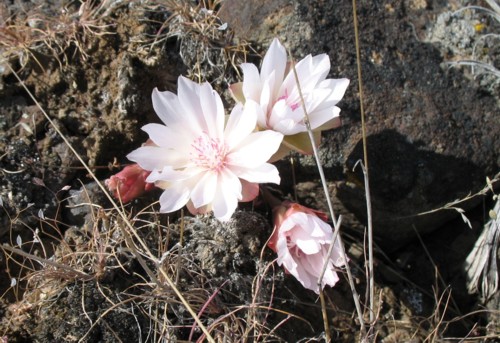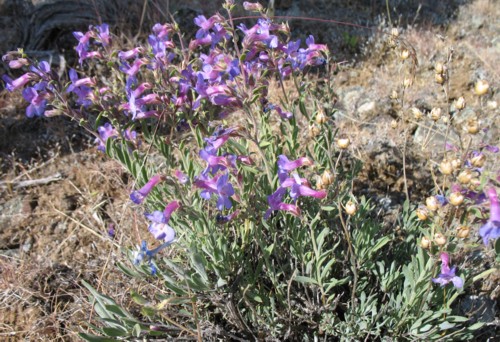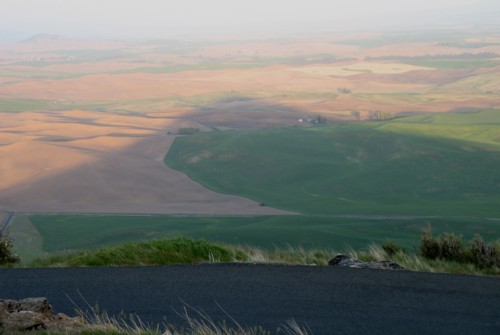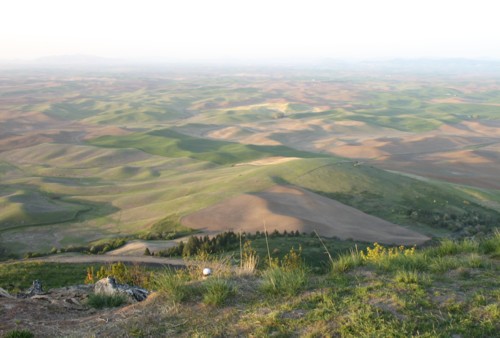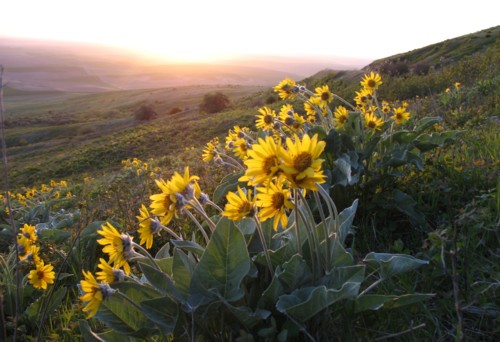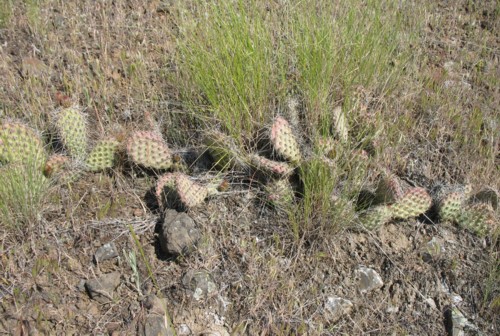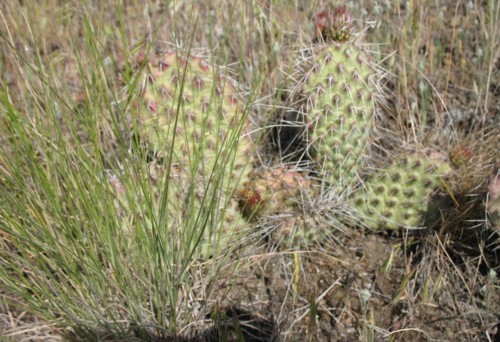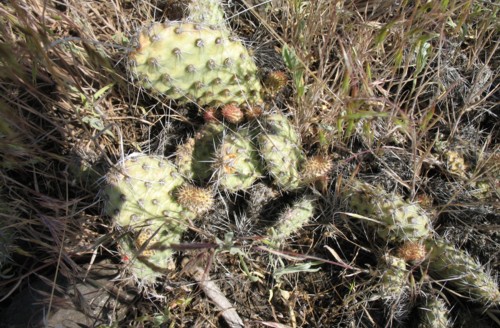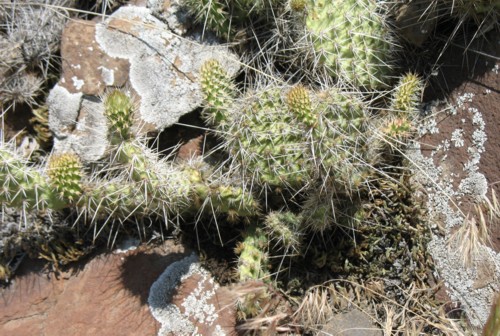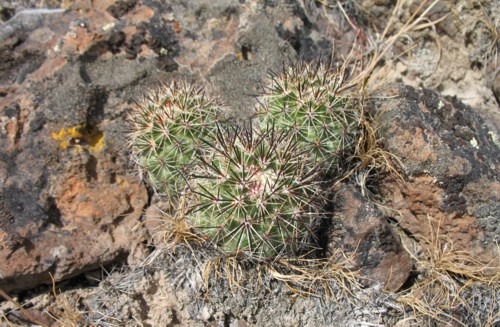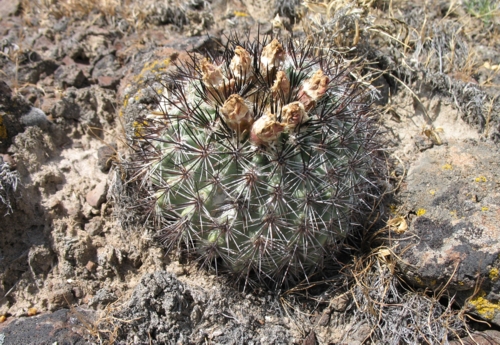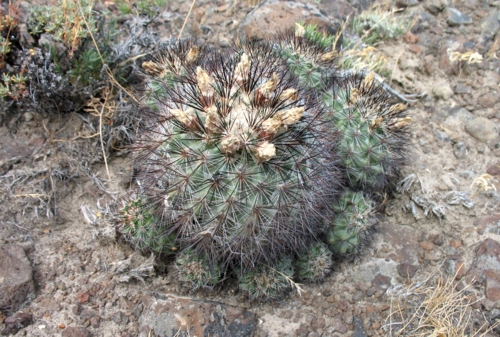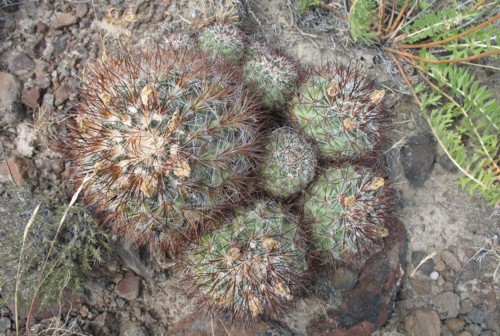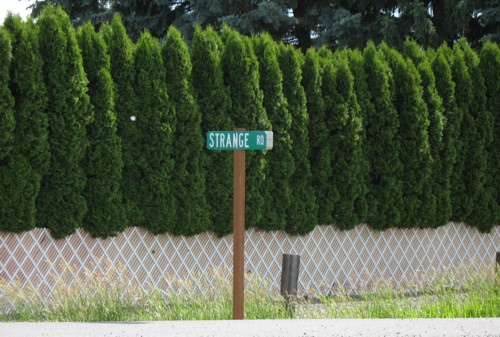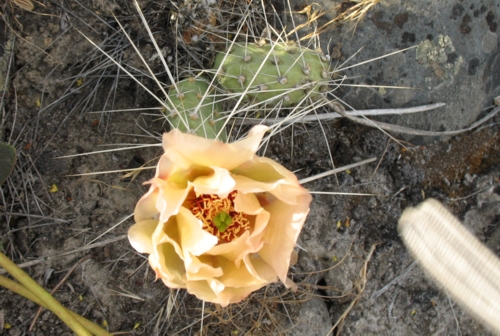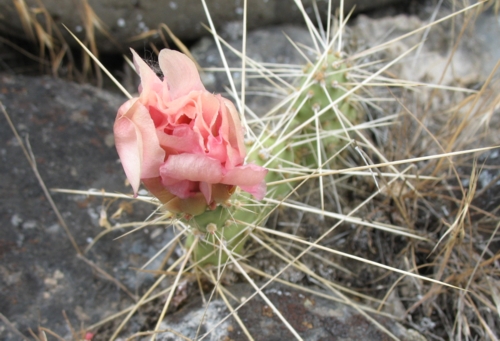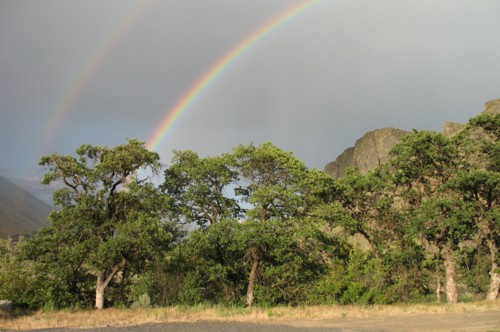|
May 2006 Failing to find many of the native cacti I sought on my 2005 excursions to eastern Washington, I felt my life would not have been complete if I did not return to look once again. It is always a pleasure to return to eastern Washington, where the sun shines, the people are nice, and cacti and interesting plants abound. It's so close, yet I don't have the opportunity to visit there nearly as much as I would like. Unlike some sequels, this one wasn't a disappointment. This was because I had some help: I met up with a serious cactus enthusiast in Rock Island, Dixie Dringman. She showed me two different locations where our native Pediocactus nigrispinus could be found, and one place where an interesting Opuntia grows. She also has a large collection of cacti, which is featured in the Garden Galleries here. My trip began with visits to some Seattle area nurseries, something I had scarcely had a chance to do yet that spring, a drive over Stevens Pass, and a little poking around Leavenworth. After camping north of Wenatchee by the Columbia River, it was time to meet Dixie and see some cacti!
First, a quick trip down to the Wenatchee area, where this interesting plant grows just to the southeast of the city. It is more like Opuntia fragilis than anything but has much larger pads. It may be one of a number of interesting hybrid Opuntias found throughout eastern Washington and the interior of British Columbia.
A closer view of these plants. They weren't blooming at the time, but the flowers are mostly yellow.
Next, a trip to one of central Washington's best Pediocactus nigrispinus sites near Rock Island. This hillside is in a remote area far from any paved road, and you would never know these cacti were here unless someone told you about them.
I was really impressed with the size of these cacti - sure, they're not as tall as many species of more southerly origin, but I had no idea such large cacti could be found here in Washington!
Another nice beefy Pediocactus nigrispinus.
This individual had lighter spines.
Some of the plants were solitary....
....others formed broad clumps with many offsets.
And, it was really my lucky day, because their flowering was late this year! I had hoped to get some seeds, which I didn't - but at least I wasn't too late to see some flowers!
The bright pink flowers are large enough to be seen from a great distance. The best time to find Pediocactus is when they are blooming, usually around the beginning of May. Reportedly, flower colors other than pink can occasionally be found in central Washington, but I haven't seen them yet.
Another very cool plant that grows in the same ecological niche in Eastern Washington's deserts is the deciduous Lewisia redidiva. The flowers and the leaves aren't usually seen at the same time!
Our next stop was a somewhat more accessible spot high above the Columbia River.
These Pediocactus plants were not in quite such large clumps as in the previous site, but the individual bodies were often huge.
...for example, this plant reclining at the edge of a cliff, which, at more than 1' tall, must be ancient!
Want some water, little cactus? Hehehe.
A unique white form of Lewisia redidiva.
A beautiful Penstemon species that grows in the desert.
Another cool succulent from eastern Washington, Phemeranthus spinescens. It belongs to the Portulacaceae and forms attractive mounds of green leaves in cultivation, though in the wild it looks shrivelled and stressed. It was here I said goodbye to Dixie, and thanks a lot for sharing of her time and knowledge. Then it was time to drive, drive, drive across eastern Washington. I didn't stop for anything because I don't know of any cactus sites in between the Columbia River area and the southeast corner of Washington, except near Ephrata and Soap Lake which is a bit out of the way. There may be a few scattered sites, but I don't know anything about where to find them. There were quite probably numerous Opuntia sites in the past, but now most of this area is used for agricultural production.
I thought it would be fun to stop at Steptoe Butte, an almost perfectly conical granite outcrop that sits above the rolling plains of Washington's Palouse region. I didn't photograph it from a distance, but in this view from the top of the mountain you can see its shape in the shadow. It was very cold here, and windy, and the day was nearly over.
The Palouse region is the most productive wheat growing area in the world, not only because the soil is fertile but because the ground is so hilly it has much greater surface area than flat land. Sadly, only a very tiny amount of this region with its unique grasses and wildflowers has been preserved in its natural state.
No native cacti grow here, but there are some other interesting plants such as this Balsamorhiza saggittata, which is common in many areas of eastern Washington and Oregon, and is always nice to find in bloom. As the daylight faded into darkness, I began the drive towards Moscow, Idaho, and briefly into some partially forested, higher country. It was then that the serpentine belt decided to fall out of my engine. I didn't know this at the time, though; I could only see that a bunch of warning lights came on and the car was not happy. I know a lot about plants, not cars. I looked in the engine, but in the dark I failed to notice the absence of any important belts. Although the warning lights stayed on and certain functions of the car seemed more difficult to perform, the car still drove, so I figured the best thing I could do was get back to civilization and drive into Moscow. From there, I called some of my friends to try to troubleshoot what could be wrong with the car, but we could not figure anything out. I didn't feel like staying in Moscow, so, since the car still drove, I thought I would proceed on to Clarkston, another 40 miles or so. I checked into a motel in Clarkston at about 11:30, a bit stressed out about the car, and very tired,. In the morning, the car still started, and still had the same mysterious problem. Oh well, I thought, I am here to look for cacti and I can worry about mysterious car problems when I get back. So I drove down towards Asotin to revisit the populations of Opuntia polyacantha I had discovered previously. As I drove down the George Creek Road, I noticed to my disappointment that the road was closed off just where the ascent of Myers Ridge began - and just below where the cactus were growing. This to me is an annoying trend throughout the West - more and more roads being closed off for one reason or another. In come cases there may be liability and safety reasons, but in some cases I think landowners simply don't want people tresspassing or even using easements on private land, and lobby to have roads that were formerly public closed completely to outsiders, or just put up a gate themselves. So, I returned to the Cloverland Road and decided to drive farther up it, since I never had, and perhaps I would find more cacti. As I ascended above the canyon floor, I was not disappointed.
On this hillside southwest of Asotin, I found these Opuntia polyacantha plants of a slightly more prostrate variety than the ones on George Creek Road.
A close-up of the pads and spines of Washington's O. polyacantha, with some flower buds.
Some plants had rather odd-looking, uglier pads like this.
Then it was on towards home, but of course I had to take the scenic route to look for more cacti. Here are some of the Opuntia columbiana growing above the Snake River northwest of Clarkston, close to where I found them last year.
A close up of these plants. These look almost like O. polyacantha, more so than my collections from the canyon south of Yakawawa Canyon, just north of here, from 2005. I also had a few more adventures, which I shall not relate here, and I revisited my old haunts at WSU in Pullman and at "the Embassy," the house I used to live in. The nice form of Opuntia polyacantha growing behind the Embassy (cultivated) was now completely gone: the last remains of this plant are now in my collection. Unfortunately, though, I took so much time in this area that I didn't have any time left to hunt for cacti around Vantage or Ellensburg. So, in spite of a successful trip overall, I still felt that my life lacked a sense of completion. |
|
June 2006 Finally I took it upon myself to conclude this prickly trilogy in June of the same year, which I hoped would be just the right time to find Opuntias in flower and Pediocactus with seed. The only problem was, I could only take a single day for my trip, since I had so much to do at the nursery, and, of course, I was working full-time. It's a good thing the Vantage and Ellensburg areas are only a short drive from Seattle. My first stop was Vantage, but there isn't much to tell about that except that I couldn't find any plants of Opuntia columbiana around Ginkgo Petrified Forest State Park, where I found one in 2005. It was probably removed by the Park Service because the spines presented a hazard to visitors, or some stupid reason like that. That would be ironic, but not at all surprising.
From there I drove west just a couple miles and parked the car on a hunch that this might be a good place to find Pediocactus nigrispinus. I walked straight up a rocky hillside and, after a little poking around, there they were! Talk about better luck than I had on my first cactus hunting expedition the previous summer, when I spent lots of time looking for things I couldn't find. This plant was my first siting of Pediocactus west of the Columbia River.
The plants were generally smaller than the ones Dixie showed me, but with heavier spination. They were a nice deep shade of green.
Lots of ripe seeds were to be had, though it was still just a little bit early.
They were quite happy growing out of almost pure rock. I thought of looking for more Pediocactus higher up, but I already had some seeds from the plants pictured above, and I didn't have a lot of time. So, it was onwards to.... U-Tote-Em Burgers in Ellensburg for a milkshake! Then, of course, off to look for more cacti.
They have some strange roads around Ellensburg. Once again, it was back to the scenic Yakima River Canyon (between Ellensburg and Yakima) to look for more cacti, which would probably be Opuntia columbiana, but who knows? I could find O. fragilis too. I know they are there somewhere. Mike Lee told me they were there. Dixie told me they were there even with rather specific directions. But I still can't find them! Oh well - I really need to take a whole entire day to poke around this area. And another whole entire day to look around the area between Ellensburg and Vantage for higher altitude Pediocactus. Maybe next year... Then, it was on to a site west of Naches where I knew cacti could be found.
These are interesting cacti in an interesting location. They're not out in the open desert, but along the Tieton River near the confluence with the Naches, surrounded by rather high mountains of the eastern foothills of the Cascades. (The mountain immediately to the north, which tops out at 5,000', is in my opinion a bit large to fit the criteria of a "foothill". Anyways...) These cacti seem at first closest to Opuntia columbiana, but are different from other forms - small plants with small pads and very long spines. The really interesting part is that they are brittle like O. fragilis - NOT a characteristic typical of any O. columbiana I know of. Hmm - another mysterious hybrid swarm?
They were blooming, too! Some had the expected yellow flowers...
... others had pink flowers! Or at least, they faded to pink as they expired. That was a nice surprise!
Of course, it's always cool to see native oaks east of the Cascades. I caught this shot of Quercus garryana with a rainbow, in the same site with the cacti, just as the sun was going down. I think this is about as far north as it occurs in eastern Washington. |


